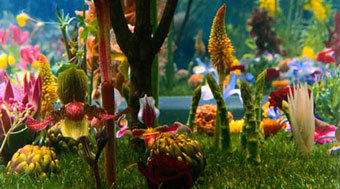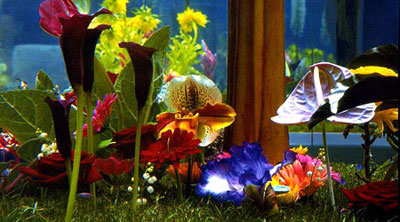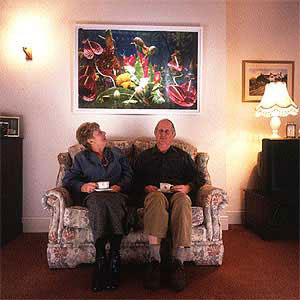Human Flower Project
Friday, March 31, 2006
Marc Quinn’s Suspended Garden
Is Marc Quinn’s “undertaking” necrophilia or conceptual art?

Detail from “Garden,” by Marc Quinn
Photo: Pruned
How’s that tulip blooming next to a chrysanthemum? One’s a springtime flower, the other autumnal. Can a calla lily really flourish in the same bed as coxcomb? And how come we’ve begun to feel like a grouper?
Marc Quinn‘s peculiar Garden (2000) is one of the strangest floral art works we’ve yet come across. (Unfortunately, we haven’t actually seen the piece in person, only online, as you may also here.)
Quinn (b. 1964, London) managed to collect 1000 flowers in full bloom from around the world and sank them all in “twenty-five tons of liquid silicone,” maintained at “a constant temperature of -80˚ Celsius.” His garden is frozen, but not frosty. Rather, the plants look as if they’re blooming in some intergalactic terrarium, the kind you might see while waiting for a root canal in a dentist’s office on Jupiter.
Quinn is one of a number of contemporaries—we think principally of Andres Serrano—who’ve gone for turning body parts and fluids into art. We learn that Quinn “is best known for Self (1991), a model of his head made from nine pints of his frozen blood… More recently, Quinn created a model of his four-day-old son’s head, made from his girlfriend’s liquidised placenta.”

Detail from “Garden,” by Marc Quinn
Photo: Pruned
Of “Garden,” Quinn said, ““The flowers, when they freeze, become pure image. They become an image of perfect flower, because in reality their matter is dead and they are suspended in a state of transformation between pure image and pure matter.”
Of course, Rachel Ruysch and Fantin Latour made flowers into “pure image” with paint. In our view it’s they who were the “conceptual artists,” by leaving the “matter” of flowers to die in the studio while their floral art endures to this day. Quinn’s endeavor strikes us as closer to taxidermy. He’s described his own work as “eerie,” and we’d agree, much like dining at Mikeska’s restaurant down the road in Columbus, Texas. There, several dozen deer, bobcat, and antelope heads jut off the walls; digging into the fine German potato salad, there’s the distinct feeling that one is being watched.
We would very much like to have the chance to see Quinn’s “Garden” up close and in person. Right now, though, we welcome your opinions and comments.
 Sue and Tim Pickering
Sue and Tim Pickering
live with a work by Marc Quinn
Photo: Richard Waite
You may also enjoy reading the reactions of Tim and Sue Pickering to Quinn’s landscapes. The Pickerings, as part of a cultural experiment (talk about eerie!), had a Quinn piece hang in their house on the outskirts of Birmingham, England.
“I’m conventional, I suppose.” Tim said. “Modern art – even stuff by Picasso – I don’t understand it really; I need to have it explained. A pile of bricks on the floor or a cow in formaldehyde leaves me cold.” How did Marc Quinn leave him?
“That’s not entirely a bad thing,” he remarked on first seeing Quinn’s “Italian Landscape”—a detailed photograph of another 3D frozen garden. “It makes you think, ‘There should be a mouse going through there, or a hedgehog or something.’”
Sorry, Tim. If you want hedgehogs, you’ll need to take up silicon art yourself or head out to Mikeska’s restaurant.




